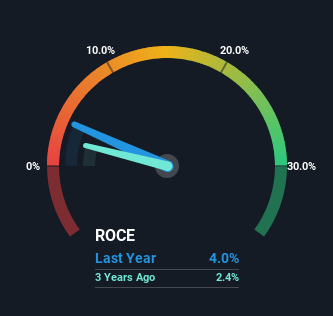- Japan
- /
- Electronic Equipment and Components
- /
- TSE:6742
Kyosan Electric Manufacturing (TSE:6742) May Have Issues Allocating Its Capital

What financial metrics can indicate to us that a company is maturing or even in decline? Typically, we'll see the trend of both return on capital employed (ROCE) declining and this usually coincides with a decreasing amount of capital employed. Basically the company is earning less on its investments and it is also reducing its total assets. So after we looked into Kyosan Electric Manufacturing (TSE:6742), the trends above didn't look too great.
Understanding Return On Capital Employed (ROCE)
For those who don't know, ROCE is a measure of a company's yearly pre-tax profit (its return), relative to the capital employed in the business. The formula for this calculation on Kyosan Electric Manufacturing is:
Return on Capital Employed = Earnings Before Interest and Tax (EBIT) ÷ (Total Assets - Current Liabilities)
0.04 = JP¥2.5b ÷ (JP¥130b - JP¥68b) (Based on the trailing twelve months to March 2024).
Therefore, Kyosan Electric Manufacturing has an ROCE of 4.0%. Ultimately, that's a low return and it under-performs the Electronic industry average of 8.9%.
Check out our latest analysis for Kyosan Electric Manufacturing

While the past is not representative of the future, it can be helpful to know how a company has performed historically, which is why we have this chart above. If you'd like to look at how Kyosan Electric Manufacturing has performed in the past in other metrics, you can view this free graph of Kyosan Electric Manufacturing's past earnings, revenue and cash flow.
What The Trend Of ROCE Can Tell Us
In terms of Kyosan Electric Manufacturing's historical ROCE movements, the trend doesn't inspire confidence. To be more specific, the ROCE was 5.2% five years ago, but since then it has dropped noticeably. On top of that, it's worth noting that the amount of capital employed within the business has remained relatively steady. Since returns are falling and the business has the same amount of assets employed, this can suggest it's a mature business that hasn't had much growth in the last five years. If these trends continue, we wouldn't expect Kyosan Electric Manufacturing to turn into a multi-bagger.
While on the subject, we noticed that the ratio of current liabilities to total assets has risen to 52%, which has impacted the ROCE. Without this increase, it's likely that ROCE would be even lower than 4.0%. What this means is that in reality, a rather large portion of the business is being funded by the likes of the company's suppliers or short-term creditors, which can bring some risks of its own.
The Bottom Line
In summary, it's unfortunate that Kyosan Electric Manufacturing is generating lower returns from the same amount of capital. Yet despite these poor fundamentals, the stock has gained a huge 105% over the last five years, so investors appear very optimistic. Regardless, we don't feel too comfortable with the fundamentals so we'd be steering clear of this stock for now.
Kyosan Electric Manufacturing does have some risks, we noticed 3 warning signs (and 1 which shouldn't be ignored) we think you should know about.
If you want to search for solid companies with great earnings, check out this free list of companies with good balance sheets and impressive returns on equity.
Valuation is complex, but we're here to simplify it.
Discover if Kyosan Electric Manufacturing might be undervalued or overvalued with our detailed analysis, featuring fair value estimates, potential risks, dividends, insider trades, and its financial condition.
Access Free AnalysisHave feedback on this article? Concerned about the content? Get in touch with us directly. Alternatively, email editorial-team (at) simplywallst.com.
This article by Simply Wall St is general in nature. We provide commentary based on historical data and analyst forecasts only using an unbiased methodology and our articles are not intended to be financial advice. It does not constitute a recommendation to buy or sell any stock, and does not take account of your objectives, or your financial situation. We aim to bring you long-term focused analysis driven by fundamental data. Note that our analysis may not factor in the latest price-sensitive company announcements or qualitative material. Simply Wall St has no position in any stocks mentioned.
About TSE:6742
Kyosan Electric Manufacturing
Develops, manufactures, and sells electromechanical interlocking, road traffic signal equipment, and cuprous oxide rectifiers in Japan and internationally.
6 star dividend payer with solid track record.
Similar Companies
Market Insights
Community Narratives




